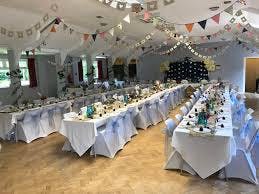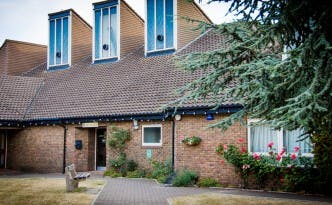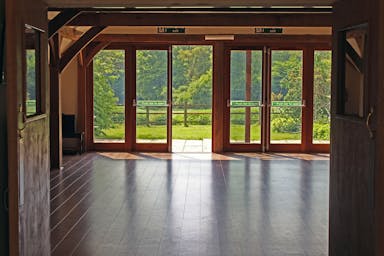Skip to content







 Buckinghamshire
Buckinghamshire
Village halls in Buckinghamshire
Bath & NE Somerset 2 2

Bellingdon and Asheridge Village Hall
Buckinghamshire
COVID and 2020 shone a new light on the role of village halls and community associations with our committee quickly becoming aware of and competent on Zoom to communicate remotely. This enabled us to set up a support group working in collaboration with other local groups to ensure all our residents were safe, had supplies of shopping and prescriptions along with moral support and just a chat on the phone to reduce the feeling of isolation and concern.
The resident’s mastery of Zoom enabled us to establish Quiz nights to replace our monthly pub nights allowing people to remain in touch and keep the banter going!
At the beginning of the pandemic in 2020 we ensured the hall was COVID safe within the government guidelines (with clarity provided by ACRE and CIB) enabling its continued use, including a tuition group throughout the summer. During the latest lockdown the hall has been closed for hire with the playing fields and playground (when permitted) remaining open, providing an open space for people to exercise.
Our hall, playground and adjoining playing fields support the village of Bellingdon and hamlet of Asheridge; it is located two miles north of Chesham, and situated along a ridge, typical of the Chiltern Hills.
It is built on ground donated by Miss Marion Thompson, a local resident and officially opened on 6th November 1948. Until 1965 the land adjoining was rented for use as a playing field but in that year, we were able to purchase it by local fundraising.
The hall facilities have been continuously improved enabling it to be used for a diverse range of activities from village groups, community events, exercise classes, and family celebrations especially children’s parties and weddings. In recent years it has established itself as a festival venue for Brazilian dancing. The playing fields with separate changing rooms support local football leagues and training.
The pandemic has been a huge learning curve, clearly demonstrating the importance of village halls and community associations and their flexibility in adapting to the changing and diverse requirements of their communities.

Chalfont St Peter Community Centre
Buckinghamshire
After the First World War, the village wished to have a Memorial Hall of those who had lost their lives. A wooden army building in Denham was purchased and re-erected on a site at the corner of Market Place and Church Lane. This served the community well for many years until the major population increase in the 1950’s following the end of building restrictions on new homes.
By 1957 the old building was becoming uneconomic to maintain, nor could it be enlarged. A Committee was set up to find a site and negotiate with the County Council for a new “Community Centre”. The old building and site was sold, to be replaced by shops and living accommodation.Bucks County Council erected a new Community Centre in 1961-62 on a site at Mill Meadow owned by Amersham Rural District Council. The original building comprised the Hall and Stage, Players room, Mary Smithells room, Foyer, office and toilets.
A wooden plaque commemorates the formal opening on 15th.March 1962 by Lord Curzon of Bucks C.C. The full title, as required by the Charity Commissioners, was “Chalfont St.Peter Memorial Garden and Community Association”, to maintain the link with the former Memorial Hall. The Book of Remembrance, displayed in the Members room, contains the names of all village residents killed in the 1914-18 and 1939-45 World Wars.
The Centre was originally built by Buckinghamshire County Council, who provided a paid part-time Warden as manager. Chiltern District Council took over the arrangement, but halved the grant in 2001. The District Council and Chalfont St.Peter Parish Council both made generous grants towards the £50,000 cost of the 1992 extension. The Parish Council were our tenants from 1992 to 2006, and have made grants to various improvement projects over the years. Both the District Council and Parish Council appoint representatives to the Executive Committee. The Community Centre holds a 21 year lease from Chiltern District Council expiring in 2021.Over the years the Centre has been enlarged by the addition of a Members room, a bar, a boiler house, toilets for the disabled, the Chiltern room and most recently in 1992 by the Tony Graham room, named in memory of our late vice chairman. The Parish Council occupied part of the extension, which is now occupied by Apex Physiotherapy until 2006. Recently the bar was converted into the Misbourne Room and the Members Room was enlarged. The Community Centre also holds the lease for the Garden Club and St. Peter Player’s storage huts. In view of the age of the building, the cost of maintenance and the demand for more space plans are afoot to replace it with hopefully with a new building. A Feasibility Study has been completed and the New Building committee are considering the next steps to achieve this end. Watch this space.

Finmere Village Hall
Buckinghamshire
The present village hall was funded and built by the villagers of Finmere and opened in 1985.
Since then it has been the recipient of a number of grants and has undergone some modernisation.
It is positioned close to the centre of the village, sharing a field with both cricket and football pitches, and is regularly used by a variety of clubs and groups.
There is also a recently installed children's play area alongside the hall.

Iver Village Hall
Buckinghamshire
The old Village Hall was opened in 1881. It had a stage and was used for a large number of events – concerts, fund raising sales, meetings, parties and wedding receptions. It was demolished in the 1960s to make way for redevelopment. A Steering Committee and a Fund Raising Committee were set up to help organise the re-building of a new village hall. The County Council allocated land at West Square which was previously the site of the Garibaldi pub, Bakers Garage and F W Jones (carpenters and undertakers). The new complex would house the Iver Infant School, Kings Church and the village hall committee rooms. The Hall itself would be a shared use facility with the School and is managed in conjunction with the School and the County Council. On 13 June, 1979 a public meeting was held at Iver County Combined School (now the Junior School) to approve the Constitution of the Iver Community Association and to elect a Management Committee for the new Iver Village Hall. The official opening of the new village hall took place on 8th July 1980. One of Iver’s most distinguished former residents, HRH Princess Alexandra, the Hon Lady Ogilvy SCVC who used to live at Coppins in Bangors Road and who was held in great affection by many Iver people who remember her as a little girl shopping in the Village, officially opened the new West Square complex. The main hall is large with a floor area of 30ft x 50ft plus a stage of 30ft x 14ft with back and front access and stage lighting. There is a hatch leading to a large kitchen with a large gas cooker, hot water, fridge / freezer, dishwasher, twin sinks and plenty or work surface. China and cutlery are available for hire. Two committee rooms are available for hire. Light weight tables of various sizes and chairs are available for use in the Hall and Committee rooms. 20th Anniversary of official opening. HRH Princess Alexandria returned to the Hall to commemorate the 20th anniversary of its opening on Saturday 22nd July 2000. The Management Committee have recently overseen a refurbishment of the premises after nearly 35 years of use. New floors, windows, paintwork, hall curtains, toilets , hall chairs and other works – some of which are ongoing – have been done

Penn Street Village Hall
Buckinghamshire
In the heart of the attractive village of Penn Street, this oak-built hall has already proved to be very popular with residents and near-by groups. After the collapse of the previous hall’s roof in 2000 a campaign was started by the villagers to raise funds for a new building. Applications were made to a number of funds and eventually the new hall was opened by The Earl Howe in June 2008. The hall is now used by a variety of village-based groups and societies and the aim is to keep its function as central to the village community while making it available to hire by those elsewhere.

Weedon Old Schoolroom
Buckinghamshire
Weedon is a small rural village, near Aylesbury in Buckinghamshire. Its village hall dates back to 1870, but, like so many halls, didn’t begin its life as a village hall. Its original purpose was as an “Infant School, [as a subsidiary to the Hardwick Church of England School], for Church of England services and other purposes”. It even had its own, attached, caretaker’s cottage.
It was built at the instigation of Mrs Barbara Cazenove, widow of the late Henry Cazenove, a stockbroker, who lived at Lilies, Weedon. It is believed its design was by the well-known Victorian architect George Devey, who had overseen the rebuilding of Lilies. Mrs Cazenove took an interest in, and financially supported the Infant School, until her death in 1905.
On the death of Mrs Cazenove, the building passed entirely into the hands of the Rector and Churchwardens, of the parish. Just prior to that, on 6th February 1904, the Bishop of Oxford had licensed the building “for Divine Service and Holy Communion”. In 1924 it was conveyed, by the then Rector and Churchwardens, to the Parochial Church Council [PCC] of Hardwick and Oxford Diocesan Board. The building was then known by villagers as Weedon Schoolroom. A Sunday School was held there until the 1970s, together with meetings, and groups like the WI. The church services have continued until the present day, with the exception of the pandemic.
In 1985, because of its special architectural and historic interest, it became a listed building. Despite this, the building lacked regular investment, and by the 1980s was in a poor state of repair and without the amenities of the time. A committee was formed to plan for the hall’s future. Trustees were elected to run the hall, a lease taken from the Oxford Diocesan Board of Finance and the PCC of the Parish of Hardwick with Weedon, and fund raising began. Thanks to village support, generous donations and lottery grants, the building underwent a complete refurbishment and modernisation and reopened in 2002.
Today this wonderful historic building is thriving. It is at the heart of the community, and hosts a wide range of activities and events, which are about to resume as lockdown measures ease.
Want to print your doc?
This is not the way.
This is not the way.

Try clicking the ··· in the right corner or using a keyboard shortcut (
CtrlP
) instead.